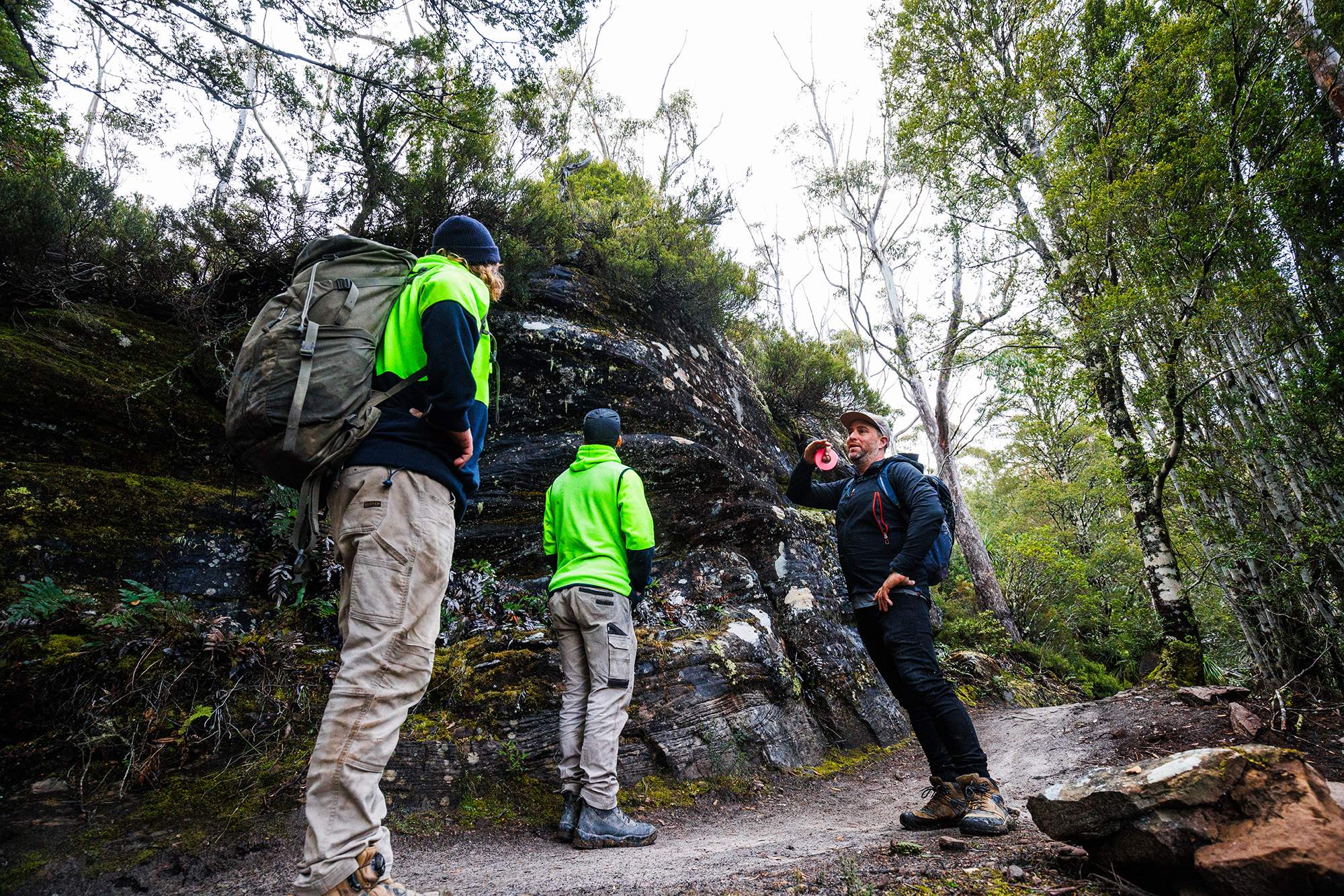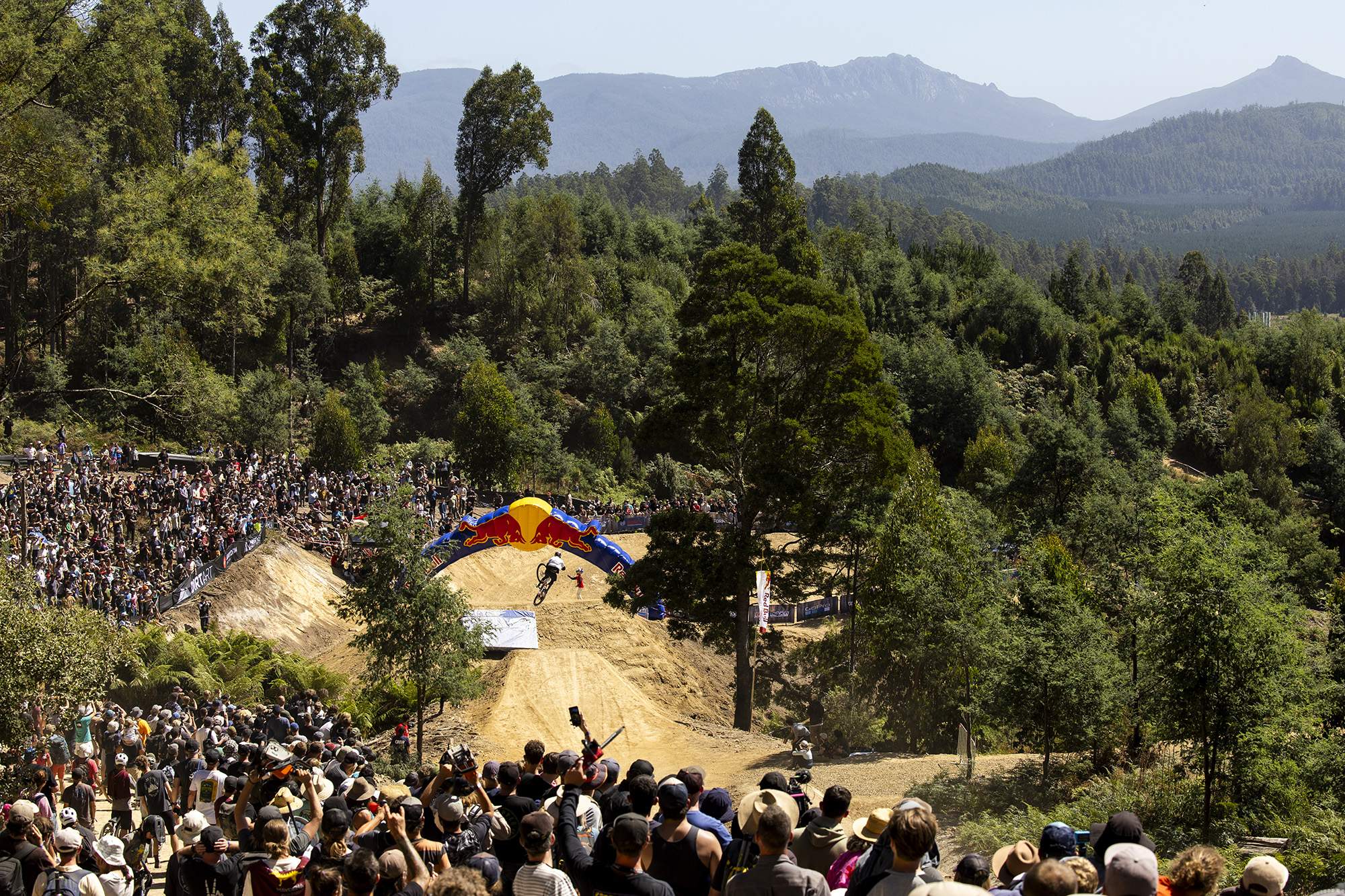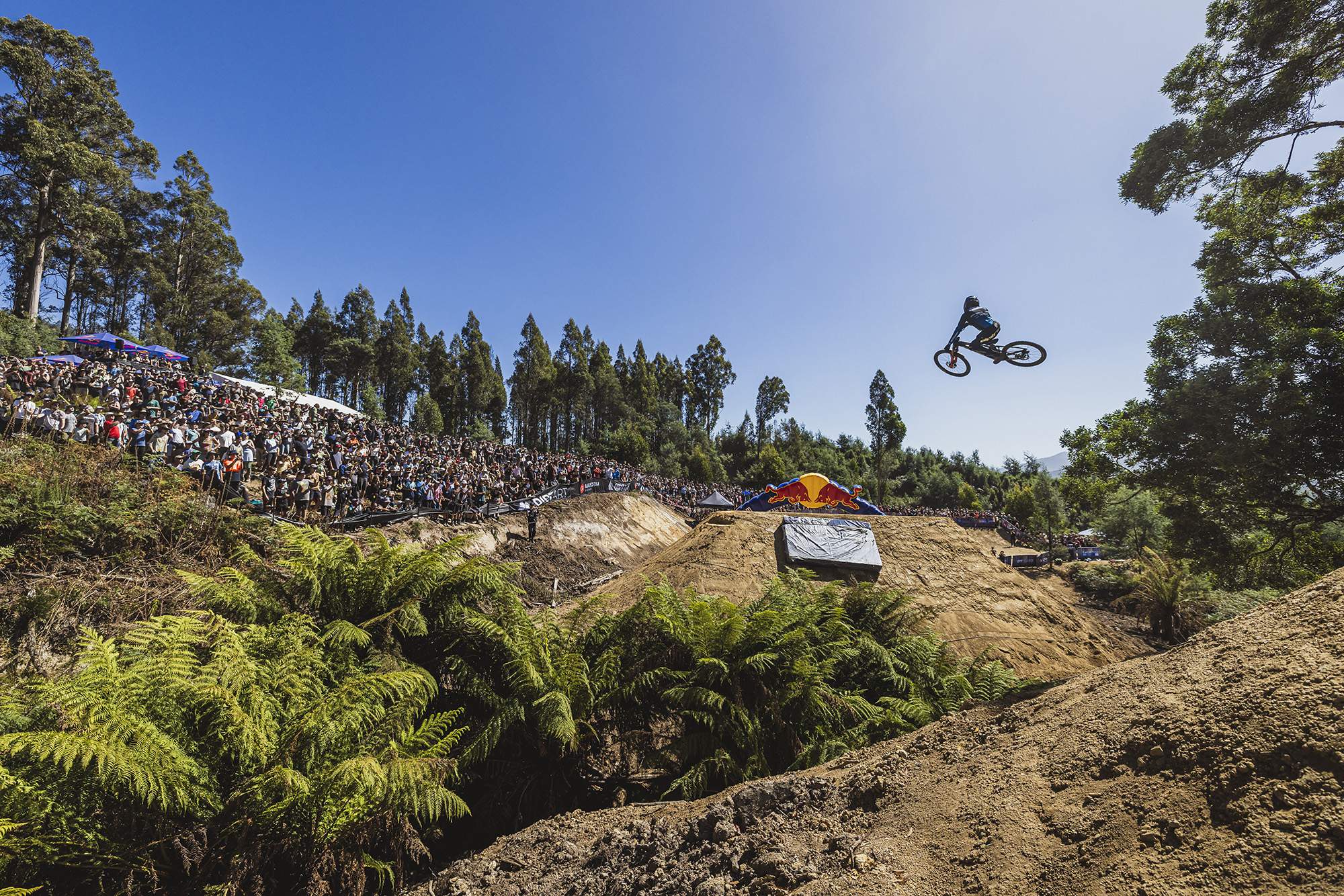With millions and millions of viewers from across the globe tuned in to watch the action coming from the next instalment of Hardline, we look back at the epic sister Hardline event that went down in Maydena earlier this year.
Thousands upon thousands of spectators poured through the ticking gates to witness the spectacle live and there is no question that the first ever Hardline event held outside of the UK was a resounding success. As everyone saw ‘from the outside looking in’ the track that the riders rode was incredible. And from the ‘inside looking out’ the planning and logistics that went into making the event even possible was equally incredible. And in this article we’re going to focus on the latter.
The main man behind the event and the man behind Maydena Bike Park, Simon French, was generous enough with time to sit down post-event for this exclusive recap chat about some of the lesser known things that went on behind the scenes of the ‘big show’.
[R]: The ’live stream’ from the race that beamed out across the globe was a phenomenal production. How many cameras and production crew did it take to make it all happen?
Simon: The broadcast side of the event is huge! I worked directly with the producers on the camera plan, which involved the better part of a week on the hill just planning and testing camera locations, camera types, drone flight paths etc. In the end we had over 40 cameras on the hill, which included automated cameras, manned cameras, and three drones. I don’t have the final number, but the production crew was over 60 staff on event day.
[R]: How many metres of cable were laid beside the course in order to beam the action?
We ended up with close to 6km of cabling installed on the hill, which included one single, unbroken length of cable from the top to bottom of the course (that was a fun one to install *insert maximum sarcasm*!)
[R]: What did the final length of the course that the riders raced end up being?
The final course was around 2.3km long. We will have a slightly longer course next year, pushing out over 2.5km.
 [R]: How much elevation gain/lose did the course boast?
[R]: How much elevation gain/lose did the course boast?
It was significant, 580 vertical metres, 2.3km in distance and the winning rider (Ronan Dunne) did it in a time of 3:08!
[R]: How long was the biggest jump?
The Creek Gap was the biggest jump at 75ft to the knuckle, or 80ft to the sweet spot. And keeping in mind that Creek Gap was shortened quite a bit just before the event got underway!
[R]: How high was the biggest gap?
The tallest drop was over 30ft!
[R]: How many laps of the course combined did the riders do throughout practise and competition?
It’s hard to put an exact number on how many full laps were ridden as a lot of riders focused on just doing sections of the track to begin with. Day one of practice for instance was spent by the riders working through and ticking off the big features, so no one had done a full lap until day 2. We did have some weather issues, that limited practice time a little.
In the end I would say most riders would have completed maybe 4-5 full laps come race day (with more partial laps and sessions), which they were all apparently comfortable with.
[R]: What was the top speed reached by a rider throughout the contest?
I think we got some riders over 75km/h in the end. The fastest section of the course was the lead into the Creek Gap, which made for an exciting finish! Generally speaking the course was faster than we anticipated – I was about 20 seconds off with my predicted race time.
[R]: In terms of creating the insanely epic course how many man hours and how many machine hours?
We only had 3.5 months to build the course (which included building the new jump trail for the Jump Jam, and building the event village and roads), so it was a pretty crazy period. We had an average of 12 staff on course for this period, so all in all we were close to 7,000 staff hours into the course.
[R]: How much dirt got moved in order to create the course and event site?
A lot! I don’t have final volumes, but for a lot of the build we had 6+ excavators on the project, including 20t, 25t, 15t, 5t, 3.5t, and 1.7t machines. There was also a hell of lot of hand work putting together some really complicated rock paving through a lot of the technical areas.
You’ll never really see the true extent of it on any broadcast, but the top of the course was actually really technical. We also had a team of trades who killed it with the steel and timber work on the big features.
 [R]: 5000+ spectators through the gates – what sort of infrastructure did the bike park have to put in place in order to deal with that many extra people being on site/in town for the event?
[R]: 5000+ spectators through the gates – what sort of infrastructure did the bike park have to put in place in order to deal with that many extra people being on site/in town for the event?
We sold out at 5,000, and ended up adding another 500, which sold out nearly instantly. We will definitely have a larger capacity next year. As most people would know, the town of Maydena is tiny, so there was a lot of work done in figuring out how to get everyone into the venue. We definitely put a lot of work into building a brand new event village space to fit the expo and crowd, which all worked a treat. The challenge for us is less the venue itself, and more the town with things such as parking.
[R]: How much prize money was handed out to the podium getters?
All the riders get an appearance fee, and their accommodation and meals covered. In terms of prize money, I couldn’t quote it off the top of my head, but it was decent!
[R]: How many Red Bulls and beers were consumer across the week?
Lots! All beverages combined we went through tens of thousands across the event week. Must have been a lot of thirsty people!
[R]: How many meals were served up to spectators and attendees on site across the week?
I know we went through close to 1,000 meals a day catered just for event staff and athletes. In terms of spectators there would have been countless thousands when you combined all of the sales from all of the many food trucks, stalls plus our onsite kiosk/restaurant.
 [R]: How much litter was left on the mountain?
[R]: How much litter was left on the mountain?
The crowd was actually really great, and there wasn’t much of anything left up on the hill. We were definitely limiting single use plastics and avoided traditional course bunting so that we could limit waste. As a ‘Trash Free Trails’ event, we were very much working to minimise waste across the board. Next year will be even better, with more reusable products across the board – this year was tough with the timelines we had to work with, but the team managed to pull it off impressively well.
[R]: How much would you estimate hosting Hardline injected into the Tassie economy?
Using very conservative numbers, the event injected well over $2.5m directly into the local and regional economy just from the event visitors. As we used almost exclusively Tasmanian businesses for all event deliverables, we also injected well over $1m into local suppliers etc. Obviously the marketing value of the event was also massive!
[R]: How many people online viewed the event live or the replay?
The broadcast stats aren’t shared publicly by Red Bull, but I can say the broadcast viewership exceeded all expectations. The YouTube replay has close to 1.1m views so far as well, and this climbs every day.
[R]: When you team up with a company as big as RedBull to host a globally viewed event the level of expectation is clearly going to be staggering, what sort of undertaking and commitment was involved from you guys, the bike park, to live up to your end of the deal?
To be honest the biggest challenge we faced was actually the timeline/leadtime. We are a small team, and the Red Bull Australia events team is also quite small. The amount of work that went into event preparations was staggering. I was working 100 hour weeks, 7 days a week for a couple of months helping our team pull it all together. As you say, expectations are high for Red Bull, and we also hold ourselves to very high standards for events. We were happy with the end result, but it will be a lot bigger and better next year – event planning for 2025 started before we even hosted this years event.
[R]: We already know that Hardline will be back here for at least the next 2 years – are you guys planning to make some changes to the set-up (the race course and event site) heading into next year or will it remain pretty similar?
The course will be similar- the riders loved it, so we don’t want to mess with a good thing. The big features all worked perfectly, so we won’t be messing with those next year (they may go bigger in year 3). We will be adding a few more big features through the course, particularly through the middle section. The course will extend down into the main event village next year, which will include a couple more big features. The event site will see some more work as we sold out the expo next year and will need more space, and will also need to make room for some extra crowds.
We will be refining the Gravity Fest program for the broader event week, with some exciting things announced over the coming weeks.
[R]: Bring on Hardline Au 2025 – we can’t wait!
We can’t wait either! And event date for ’25 will be announced in the not too distant future.



